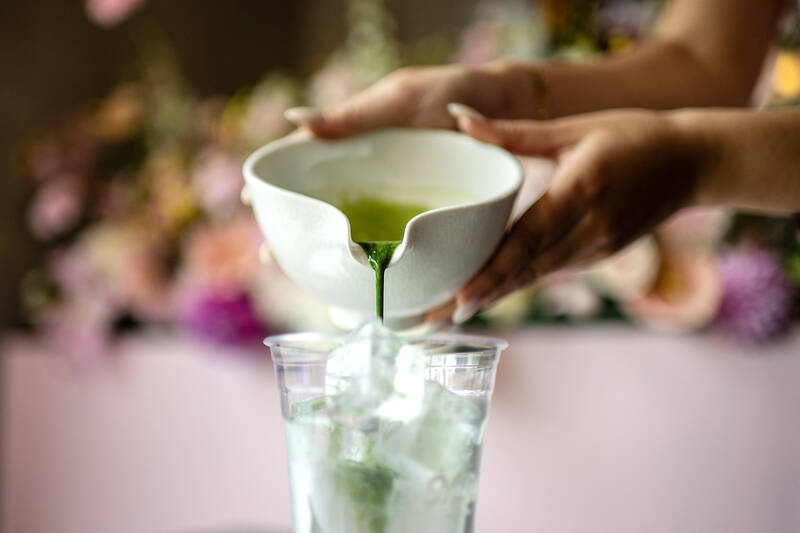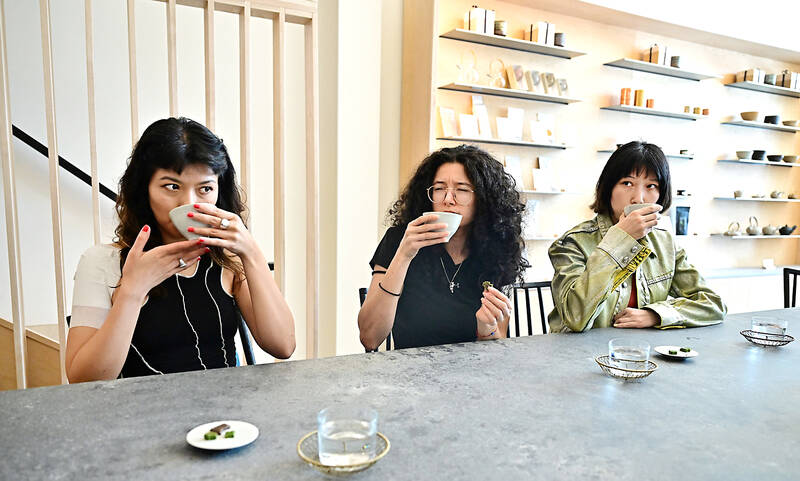At a minimalist Los Angeles matcha bar, powdered Japanese tea is prepared with precision, despite a global shortage driven by the bright green drink’s social media stardom.
Of the 25 types of matcha on the menu at Kettl Tea, which opened on Hollywood Boulevard this year, all but four were out of stock, the shop’s founder Zach Mangan said.
“One of the things we struggle with is telling customers that, unfortunately, we don’t have” what they want, he said.

Photo: AFP
With its deep grassy aroma, intense color and pick-me-up effects, the popularity of matcha “has grown just exponentially over the last decade, but much more so in the last two to three years,” the 40-year-old explained.
It is now “a cultural touchpoint in the Western world” — found everywhere from ice-cream flavor boards to Starbucks. This has caused matcha’s market to nearly double over a year, Mangan said.
“No matter what we try, there’s just not more to buy.”

Photo: AFP
LONG TERM ENDEAVOR
Thousands of kilometers away in Sayama, northwest of Tokyo, Masahiro Okutomi — the 15th generation to run his family’s tea business — is overwhelmed by demand.
“I had to put on our Web site that we are not accepting any more matcha orders,” he said.
Producing the powder is an intensive process: the leaves, called “tencha,” are shaded for several weeks before harvest, to concentrate the taste and nutrients.
They are then carefully deveined by hand, dried and finely ground in a machine.
“It takes years of training” to make matcha properly, Okutomi said. “It’s a long-term endeavor requiring equipment, labor and investment.”
“I’m glad the world is taking an interest in our matcha... but in the short term, it’s almost a threat — we just can’t keep up,” he said.
INTENSIFYING CRAZE
The matcha boom has been fueled by online influencers like Andie Ella, who has more than 600,000 subscribers on YouTube and started her own brand of matcha products.
At the pastel-pink pop-up shop she opened in Tokyo’s hip Harajuku district, dozens of fans were excitedly waiting to take a photo with the 23-year-old Frenchwoman or buy her cans of strawberry or white chocolate flavored matcha.
“Matcha is visually very appealing,” Ella said.
To date, her matcha brand, produced in Japan’s rural Mie region, has sold 133,000 cans. Launched in November 2023, it now has eight employees.
“Demand has not stopped growing,” she said.
Last year, matcha accounted for over half of the 8,798 tonnes of green tea exported from Japan, according to agriculture ministry data — twice as much as a decade ago.
Tokyo tea shop Jugetsudo, in the touristy former fish market area of Tsukiji, is trying to control its stock levels given the escalating demand.
“We don’t strictly impose purchase limits, but we sometimes refuse to sell large quantities to customers suspected of reselling,” said store manager Shigehito Nishikida.
“In the past two or three years, the craze has intensified: customers now want to make matcha themselves, like they see on social media,” he added.
TARIFF THREAT
Anita Jordan, a 49-year-old Australian tourist in Japan, said her “kids are obsessed with matcha.”
“They sent me on a mission to find the best one,” she laughed.
The global matcha market is estimated to be worth billions of dollars, but it could be hit by US President Donald Trump’s tariffs on Japanese products — currently 10 percent, with a hike to 24 percent in the cards.
Shortages and tariffs mean “we do have to raise prices. We don’t take it lightly,” said Mangan at Kettl Tea, though it hasn’t dampened demand so far.
“Customers are saying: ‘I want matcha, before it runs out.’”
At Kettl Tea, matcha can be mixed with milk in a latte or enjoyed straight, hand-whisked with hot water in a ceramic bowl to better appreciate its subtle taste.
It’s not a cheap treat: the latter option costs at least US$10 per glass, while 20 grams of powder to make the drink at home is priced between US$25 and US$150.
Japan’s government is encouraging tea producers to farm on a larger scale to reduce costs.
But that risks sacrificing quality, and “in small rural areas, it’s almost impossible,” Okutomi said.
The number of tea plantations in Japan has fallen to a quarter of what it was 20 years ago, as farmers age and find it difficult to secure successors.
“Training a new generation takes time ... It can’t be improvised,” Okutomi said.

Last week, on the heels of the recall election that turned out so badly for Taiwan, came the news that US President Donald Trump had blocked the transit of President William Lai (賴清德) through the US on his way to Latin America. A few days later the international media reported that in June a scheduled visit by Minister of National Defense Wellington Koo (顧立雄) for high level meetings was canceled by the US after China’s President Xi Jinping (習近平) asked Trump to curb US engagement with Taiwan during a June phone call. The cancellation of Lai’s transit was a gaudy

From Godzilla’s fiery atomic breath to post-apocalyptic anime and harrowing depictions of radiation sickness, the influence of the nuclear bombings of Hiroshima and Nagasaki runs deep in Japanese popular culture. In the 80 years since the World War II attacks, stories of destruction and mutation have been fused with fears around natural disasters and, more recently, the Fukushima crisis. Classic manga and anime series Astro Boy is called “Mighty Atom” in Japanese, while city-leveling explosions loom large in other titles such as Akira, Neon Genesis Evangelion and Attack on Titan. “Living through tremendous pain” and overcoming trauma is a recurrent theme in Japan’s

As last month dawned, the Democratic Progressive Party (DPP) was in a good position. The recall campaigns had strong momentum, polling showed many Chinese Nationalist Party (KMT) lawmakers at risk of recall and even the KMT was bracing for losing seats while facing a tsunami of voter fraud investigations. Polling pointed to some of the recalls being a lock for victory. Though in most districts the majority was against recalling their lawmaker, among voters “definitely” planning to vote, there were double-digit margins in favor of recall in at least five districts, with three districts near or above 20 percent in

The great number of islands that make up the Penghu archipelago make it a fascinating place to come back and explore again and again. On your next trip to Penghu, why not get off the beaten path and explore a lesser-traveled outlying island? Jibei Island (吉貝嶼) in Baisha Township (白沙鄉) is a popular destination for its long white sand beach and water activities. However, three other permanently inhabited islands in the township put a unique spin on the traditional Penghu charm, making them great destinations for the curious tourist: Yuanbeiyu (員貝嶼), Niaoyu (鳥嶼) and Dacangyu (大倉嶼). YUANBEIYU Citou Wharf (岐頭碼頭) connects the mainland